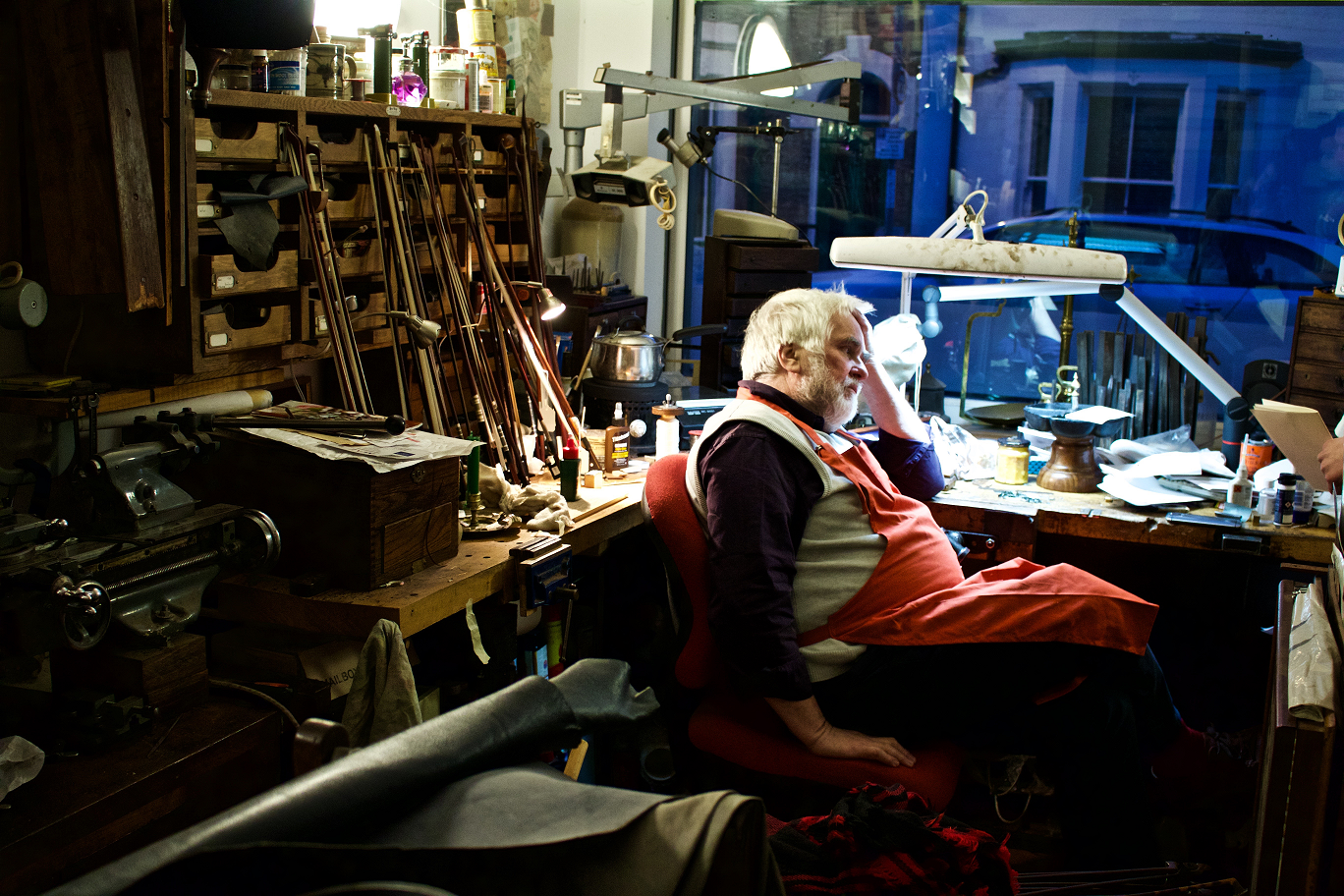
Behind the curtain: The stubbornly beautiful craft of violin making
What draws people to a craft that has remained unchanged since the 1800s?
At one end of Mill Road, Cambridge, in a room wrapped in darkness, a solitary violin case stands open. Three strips of UV light are trained on a softly spinning violin, the hazy purple glow combining with space-age silver foil to speed a drying process. And at the other end, set opposite the local pub, a large shop-front window looks onto an unruly worktop. Maybe 20 bows at various stages of completion lie stacked against a set of drawers, guarding the way to a range of machines coated with reassuringly blackened cloths.
So it is that I meet the ordered workshop of Jonathan Woolston, maker and restorer of violins, and the rather more manic workshop of Richard Wilson, professional bow maker. The two craftsmen sit in a world very much at the centre of a musical community, though one hidden from the rest of the creative sector. It’s a slow, patient, calming craft that has largely remained unchanged since the 1800s – much like the wage, Wilson jokes – but why are people still drawn to it? And do they make any money?
All in the eye
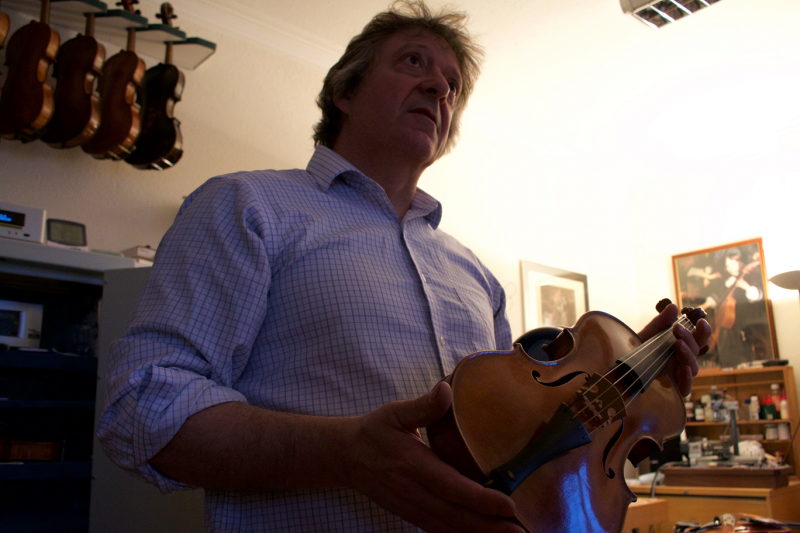 Jonathan Woolston, violin maker
Jonathan Woolston, violin maker
How do you make a violin?
|
For Jonathan, his making and repairing journey is one that has taken him through Toronto, New York, and to a maintenance and restoration post at London’s Royal Academy of Music. He’s been gouging wood into instruments in his current workshop for the past four years, and for six months alongside his colleague Francesca Vickers, but has been based in Cambridge since 1991. The two of them spend their time in tandem, meeting clients, shaping wood, following moulds, and applying varnish.
When we met, Jonathan was working on four violins, carefully adding a bit of decoration to the ribs of one.“It was the process. The process was the most interesting thing for me,” he said, his voice deep and McCartney-esque. “It sounds silly but it’s never been about the money. I want to sustain my family, but it’s important that I’m doing what I want to do. And that’s not making violins per se; it’s making individual instruments for musicians. It’s studying instruments and taking as much time as I need or want.”
Interestingly, Jonathan has never been a violinist – in fact, he can’t really play. I assumed that this would be a disadvantage, but Jonathan disagreed. “It’d be like me taking a bike from a bike track – a racing one – and then giving advice to the person who made it. Why would they listen to me? I just have a bicycle!”
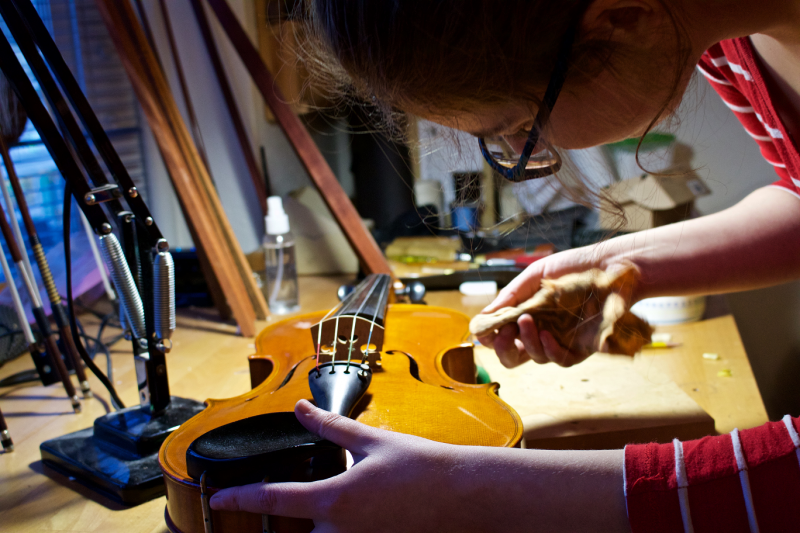 Francesca Vickers, Jonathan's assistant
Francesca Vickers, Jonathan's assistant
Jonathan’s colleague, Francesca, had a different journey – going into violin making was not something she’d necessarily planned. “I went to uni to do music, trained to be a music teacher, then went to teach for a whole year. And it was tough. I didn’t really like it that much.”
She decided to change course and go to Newark, the renowned violin school, joining 12 others for a four-year course in violin making and repair. “You get out of these courses what you put in,” she said. “You could go there, do the bare minimum, and pass. Or you could really take advantage of the workshop time.”
Although making may seem from the outside to be a small industry, everyone who graduated with her found work. Some of them decided to work internationally, but that's not because of a lack of opportunities – she said there were jobs in England that her fellow students didn’t apply for.
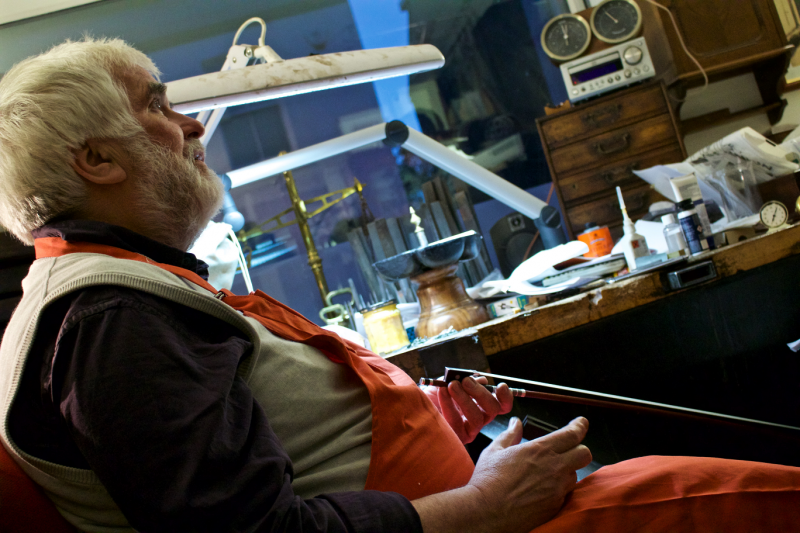 Richard Wilson, bow maker
Richard Wilson, bow maker
Similar to Jonathan, Richard had a couple of projects on the go when we met. He agreed that it was the focus of the craft that drew him in. “I do like the miniature. Everything is so exact. So disciplined. Whereas in the violin trade,” he said, leaning in, “You get a chisel and it’s like…cleaning horses out.” He chuckled. “I enjoy the discipline. And the use of the eye. It’s total, total eye.”
However, unlike Jonathan, Richard can play with the bows he makes. He used to be a professional viola player, but made the switch as a lifestyle choice: “Being a musician is a wonderful way of life. Maybe the classical side don’t throw a TV out the window, but they travel the countryside and have fun. In the beginning though I was doing so much travelling that I was the last person to know my family.
“I persuaded a maker in Bury St. Edmunds to take me on as an apprentice. Bow makers don’t have a school as such, so if you want to learn formally, you have to persuade someone to take you on. When I started I was 33 or something and my master was a little nervous – he said he’d never trained anyone that old. It’s hard to train the eye then.”
Do they make any money?
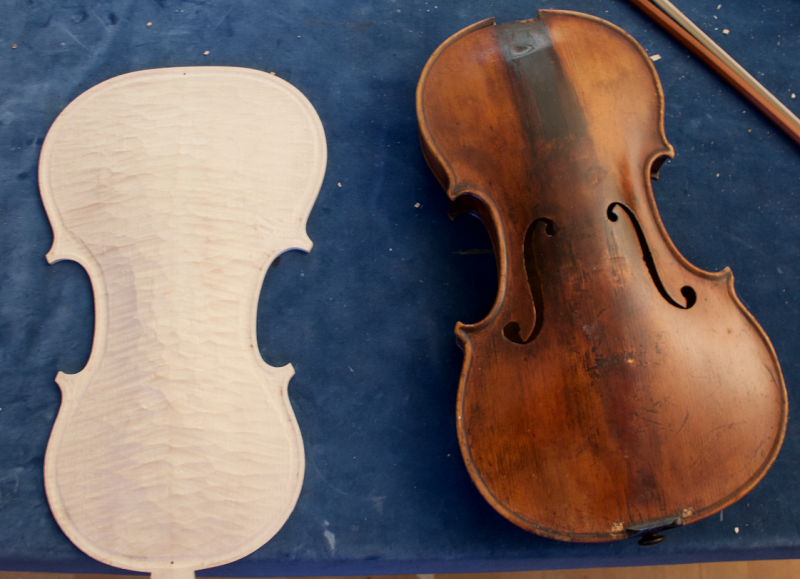
How do you make a bow?
|
One episode revealed everything there was to know about the financial side of the industry. Whilst I was talking to Richard, a call came in: Jane, a local cellist, wanted to collect her bow. An endearingly vague appointment time (I’ll be here for a bit, just come when you want) was joined by an equally endearing approach to payment (today? No, tomorrow’s fine, or whenever).
Richard discussed his ethos. “A bow by me costs about £2.5k. Because they are so personal, you can’t demand that people will buy them.
"We’re a very trusting community. You can come in here and walk away with several thousands pounds of instrument or bow, and all we’ve got is an address. And that’s fine. It’s a rather smart way of doing business. It’s not really of this century.”

Jonathan agreed. “You need enough money to continue to do what you want to do in the way you want to do it, but that’s it.”
“The last thing in the world that anyone wants is to commission something, pay for it, and not really want it. It’s really bad advertising, because each time someone picks it up out of the case, they’re going to wish they didn’t have it for whatever reason.”
“You’re comfortable – not on a minimum wage – but there isn’t a retirement plan. You just make it work.” – Richard
He accepted that some people may have changing financial circumstances. “A violin can be the price of a new car, you know. Some can’t afford that. Some want to do hire purchase. So I do a zero percent interest thing – put a reasonable time frame on it, like one year or two years – and people pay it off when they can.”
This was intruiging – there aren't many other creative industries where someone could be commissioned, spend months working on the commission, and then present it, only to be told, well, thanks but no thanks. Jonathan said that this wasn’t common, but it was definitely something that you have to deal with. “People order a violin, and when it’s finished, they have two weeks to decide if it’s really going to be their partner or not. And if it is, then everyone’s happy.”
Whatever the truth, there seemed to be a huge demand for the instruments. Both workshops had customers pop in whilst I was there, and both have long waiting lists for their work.
A reassuring calm
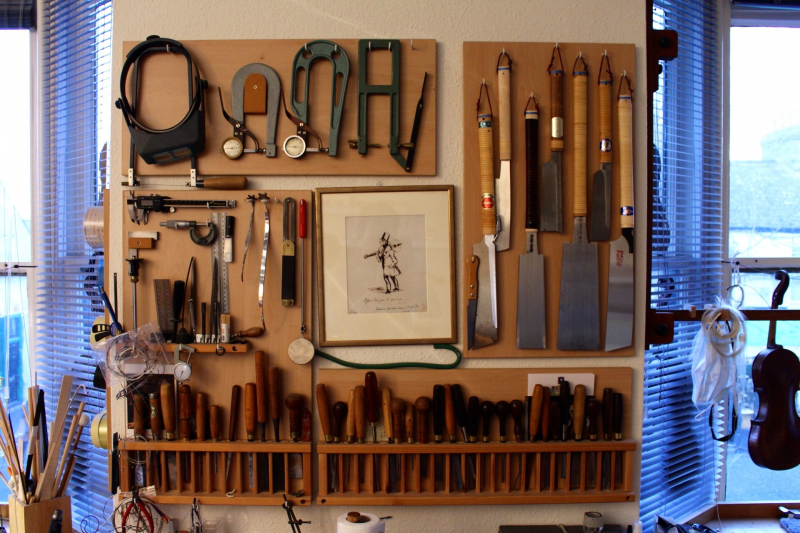
Though both Richard and Jonathan affected a sort of playful fatigue – a cheerful grump – it was glaringly obvious: these people are the craftsmen. In this industry, unlike many others, it is possible for someone to be at the heart of their community. It’s not a question of reputation, or fame, or recognition. It’s merely a deep connection to the people around you, and in many creative pursuits this seems to be either lost or sidelined.
Their world view is refreshingly Victorian: payment in the short term doesn’t matter, commissions should be kept instead of passing an unwanted item to a player, grace periods are generously maintained, scheming and trifling musicians who have no intention of purchasing anything are good-naturedly indulged. It’s a world that seeps away from the rush, the bustle, the burn of the everyday, and one that seems – despite the odds – to be at peace.
Richard Wilson makes and repairs bows.
www.bowmaker.co.uk
Jonathan Woolston makes and restores violins.
woolstonviolins.com
Original photos by Callum Alvey Photography. Callum is a freelance photographer based in Cambridge.
www.instagram.com/callum.edward
Christy Romer is the Commissioning Editor of NewProfessionals.
Join the Discussion
You must be logged in to post a comment.